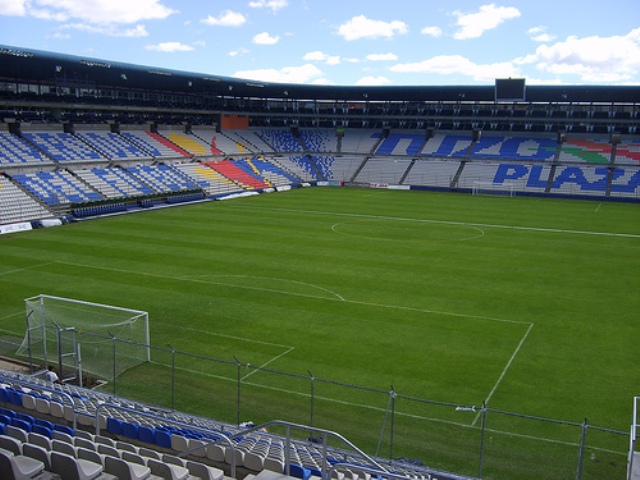|
Estadio Hidalgo
{{Mexico-sports-venue-stub ...
The Estadio Hidalgo is a football stadium named after Miguel Hidalgo y Costilla. It is located in Pachuca in the Mexican state of Hidalgo, also named in honor of Miguel Hidalgo. This sport facility is one of Mexico's mid-sized football stadiums, with a capacity of 30,000. It opened in January 1993, but recently was refurbished and modernized. It is located in the city of Pachuca, formerly a large mining site. This building is used mostly for football games and is the home of C.F. Pachuca. See also *List of football stadiums in Mexico References External linksfussballtempel.net C.F. Pachuca Sports venues in Hidalgo (state) Hidalgo Hidalgo may refer to: People * Hidalgo (nobility), members of the Spanish nobility * Hidalgo (surname) Places Mexico * Hidalgo (state), in central Mexico * Hidalgo, Coahuila, a town in the north Mexican state of Coahuila * Hidalgo, Nuevo Le├ ... [...More Info...] [...Related Items...] OR: [Wikipedia] [Google] [Baidu] |
Estadio Hidalgo Huracan
A stadium ( : stadiums or stadia) is a place or venue for (mostly) outdoor sports, concerts, or other events and consists of a field or stage either partly or completely surrounded by a tiered structure designed to allow spectators to stand or sit and view the event. Pausanias noted that for about half a century the only event at the ancient Greek Olympic festival was the race that comprised one length of the stadion at Olympia, where the word "stadium" originated. Most of the stadiums with a capacity of at least 10,000 are used for association football. Other popular stadium sports include gridiron football, baseball, cricket, the various codes of rugby, field lacrosse, bandy, and bullfighting. Many large sports venues are also used for concerts. Etymology "Stadium" is the Latin form of the Greek word " stadion" (''¤â¤ä╬Č╬┤╬╣╬┐╬Ż''), a measure of length equalling the length of 600 human feet. As feet are of variable length the exact length of a stadion depends on the exac ... [...More Info...] [...Related Items...] OR: [Wikipedia] [Google] [Baidu] |
Pachuca De Soto
Pachuca (; ote, Nju╠▒nthe), formally known as Pachuca de Soto, is the capital and largest city of the Mexican state of Hidalgo. It is located in the south-central part of the state. Pachuca de Soto is also the name of the municipality of which the city serves as municipal seat. Pachuca is located about from Mexico City via Mexican Federal Highway 85. There is no consensus about the origin of the name ''Pachuca''. It has been traced to the word ''pachoa'' (strait; opening), ''Pachoacan'' (place of government; place of silver and gold), and ''patlachuican'' (place of factories; place of tears). The official name of Pachuca is Pachuca de Soto in honor of congressman Manuel Fernando Soto, who is given credit for the creation of Hidalgo state. Its nickname of "La bella airosa" (Beautiful Airy City) comes from the strong winds that blow into the valley through the canyons to the north of the city. In the indigenous Otomi language, Pachuca is known as . The area had been long inhab ... [...More Info...] [...Related Items...] OR: [Wikipedia] [Google] [Baidu] |
Hidalgo (Mexico)
Hidalgo (), officially the Free and Sovereign State of Hidalgo ( es, Estado Libre y Soberano de Hidalgo) is one of the 31 states which, along with Mexico City, constitute the 32 federal entities of Mexico. It is divided into 84 municipalities and its capital city is Pachuca de Soto. Located in the eastern part of the country, Hidalgo is bordered by San Luis Potos├ş and Veracruz on the north, Puebla on the east, Tlaxcala and State of Mexico on the south and Quer├ętaro on the west. In 1869, Benito Ju├írez created the State of Hidalgo and made Pachuca its capital city; Ju├írez would add the name ''"de Soto"'' in recognition of Manuel Fernando Soto, who is considered the most important driving force in creating the state. The state was named after Miguel Hidalgo y Costilla, the initiator of the Mexican War of Independence. The indigenous peoples of the state, such as the Otomi, retain much of their traditional culture. In addition to Mexicans of Spanish descent, there are a ... [...More Info...] [...Related Items...] OR: [Wikipedia] [Google] [Baidu] |
Mexico
Mexico (Spanish: M├ęxico), officially the United Mexican States, is a country in the southern portion of North America. It is bordered to the north by the United States; to the south and west by the Pacific Ocean; to the southeast by Guatemala, Belize, and the Caribbean Sea; and to the east by the Gulf of Mexico. Mexico covers ,Mexico ''''. . making it the world's 13th-largest country by are ... [...More Info...] [...Related Items...] OR: [Wikipedia] [Google] [Baidu] |
State Of Hidalgo
Hidalgo (), officially the Free and Sovereign State of Hidalgo ( es, Estado Libre y Soberano de Hidalgo) is one of the 31 states which, along with Mexico City, constitute the 32 federal entities of Mexico. It is divided into 84 municipalities and its capital city is Pachuca de Soto. Located in the eastern part of the country, Hidalgo is bordered by San Luis Potos├ş and Veracruz on the north, Puebla on the east, Tlaxcala and State of Mexico on the south and Quer├ętaro on the west. In 1869, Benito Ju├írez created the State of Hidalgo and made Pachuca its capital city; Ju├írez would add the name ''"de Soto"'' in recognition of Manuel Fernando Soto, who is considered the most important driving force in creating the state. The state was named after Miguel Hidalgo y Costilla, the initiator of the Mexican War of Independence. The indigenous peoples of the state, such as the Otomi people, Otomi, retain much of their Pre-Columbian Mexico, traditional culture. In addition to Spaniards i ... [...More Info...] [...Related Items...] OR: [Wikipedia] [Google] [Baidu] |


